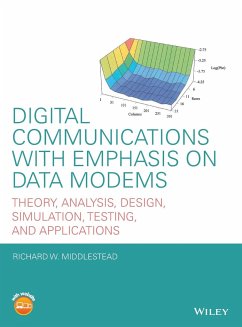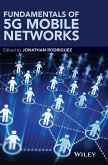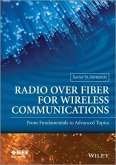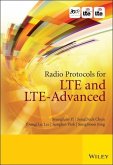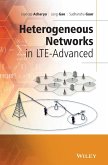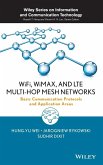Richard W. Middlestead
Digital Communications with Emphasis on Data Modems
Theory, Analysis, Design, Simulation, Testing, and Applications
Richard W. Middlestead
Digital Communications with Emphasis on Data Modems
Theory, Analysis, Design, Simulation, Testing, and Applications
- Gebundenes Buch
- Merkliste
- Auf die Merkliste
- Bewerten Bewerten
- Teilen
- Produkt teilen
- Produkterinnerung
- Produkterinnerung
This book uses a practical approach in the application of theoretical concepts to digital communications in the design of software defined radio modems.
This book discusses the design, implementation and performance verification of waveforms and algorithms appropriate for digital data modulation and demodulation in modern communication systems. Using a building-block approach, the author provides an introductory to the advanced understanding of acquisition and data detection using source and executable simulation code to validate the communication system performance with respect to theory…mehr
Andere Kunden interessierten sich auch für
![Fundamentals of 5g Mobile Networks Fundamentals of 5g Mobile Networks]() Jonathan RodriguezFundamentals of 5g Mobile Networks146,99 €
Jonathan RodriguezFundamentals of 5g Mobile Networks146,99 €![Radio Over Fiber for Wireless Communications Radio Over Fiber for Wireless Communications]() Xavier N. FernandoRadio Over Fiber for Wireless Communications139,99 €
Xavier N. FernandoRadio Over Fiber for Wireless Communications139,99 €![Next Generation Mobile Communications Ecosystem Next Generation Mobile Communications Ecosystem]() Saad Z. AsifNext Generation Mobile Communications Ecosystem138,99 €
Saad Z. AsifNext Generation Mobile Communications Ecosystem138,99 €![Radio Protocols for Lte and Lte-Advanced Radio Protocols for Lte and Lte-Advanced]() Seungjune YiRadio Protocols for Lte and Lte-Advanced174,99 €
Seungjune YiRadio Protocols for Lte and Lte-Advanced174,99 €![Heterogeneous Networks in LTE-Advanced Heterogeneous Networks in LTE-Advanced]() Joydeep AcharyaHeterogeneous Networks in LTE-Advanced121,99 €
Joydeep AcharyaHeterogeneous Networks in LTE-Advanced121,99 €![Wifi, Wimax, and Lte Multi-Hop Mesh Networks Wifi, Wimax, and Lte Multi-Hop Mesh Networks]() Hung-Yu WeiWifi, Wimax, and Lte Multi-Hop Mesh Networks143,99 €
Hung-Yu WeiWifi, Wimax, and Lte Multi-Hop Mesh Networks143,99 €![Lte Backhaul Lte Backhaul]() Lte Backhaul115,99 €
Lte Backhaul115,99 €-
-
-
This book uses a practical approach in the application of theoretical concepts to digital communications in the design of software defined radio modems.
This book discusses the design, implementation and performance verification of waveforms and algorithms appropriate for digital data modulation and demodulation in modern communication systems. Using a building-block approach, the author provides an introductory to the advanced understanding of acquisition and data detection using source and executable simulation code to validate the communication system performance with respect to theory and design specifications. The author focuses on theoretical analysis, algorithm design, firmware and software designs and subsystem and system testing. This book treats system designs with a variety of channel characteristics from very low to optical frequencies. This book offers system analysis and subsystem implementation options for acquisition and data detection appropriate to the channel conditions and system specifications, and provides test methods for demonstrating system performance. This book also:
* Outlines fundamental system requirements and related analysis that must be established prior to a detailed subsystem design
* Includes many examples that highlight various analytical solutions and case studies that characterize various system performance measures
* Discusses various aspects of atmospheric propagation using the spherical 4/3 effective earth radius model
* Examines Ionospheric propagation and uses the Rayleigh fading channel to evaluate link performance using several robust waveform modulations
* Contains end-of-chapter problems, allowing the reader to further engage with the text
Digital Communications with Emphasis on Data Modems is a great resource for communication-system and digital signal processing engineers and students looking for in-depth theory as well as practical implementations.
Hinweis: Dieser Artikel kann nur an eine deutsche Lieferadresse ausgeliefert werden.
This book discusses the design, implementation and performance verification of waveforms and algorithms appropriate for digital data modulation and demodulation in modern communication systems. Using a building-block approach, the author provides an introductory to the advanced understanding of acquisition and data detection using source and executable simulation code to validate the communication system performance with respect to theory and design specifications. The author focuses on theoretical analysis, algorithm design, firmware and software designs and subsystem and system testing. This book treats system designs with a variety of channel characteristics from very low to optical frequencies. This book offers system analysis and subsystem implementation options for acquisition and data detection appropriate to the channel conditions and system specifications, and provides test methods for demonstrating system performance. This book also:
* Outlines fundamental system requirements and related analysis that must be established prior to a detailed subsystem design
* Includes many examples that highlight various analytical solutions and case studies that characterize various system performance measures
* Discusses various aspects of atmospheric propagation using the spherical 4/3 effective earth radius model
* Examines Ionospheric propagation and uses the Rayleigh fading channel to evaluate link performance using several robust waveform modulations
* Contains end-of-chapter problems, allowing the reader to further engage with the text
Digital Communications with Emphasis on Data Modems is a great resource for communication-system and digital signal processing engineers and students looking for in-depth theory as well as practical implementations.
Hinweis: Dieser Artikel kann nur an eine deutsche Lieferadresse ausgeliefert werden.
Produktdetails
- Produktdetails
- Verlag: Wiley & Sons
- 1. Auflage
- Seitenzahl: 832
- Erscheinungstermin: 7. Juni 2016
- Englisch
- Abmessung: 286mm x 221mm x 48mm
- Gewicht: 2298g
- ISBN-13: 9780470408520
- ISBN-10: 0470408529
- Artikelnr.: 39374395
- Herstellerkennzeichnung
- Libri GmbH
- Europaallee 1
- 36244 Bad Hersfeld
- 06621 890
- Verlag: Wiley & Sons
- 1. Auflage
- Seitenzahl: 832
- Erscheinungstermin: 7. Juni 2016
- Englisch
- Abmessung: 286mm x 221mm x 48mm
- Gewicht: 2298g
- ISBN-13: 9780470408520
- ISBN-10: 0470408529
- Artikelnr.: 39374395
- Herstellerkennzeichnung
- Libri GmbH
- Europaallee 1
- 36244 Bad Hersfeld
- 06621 890
Richard W. Middlestead currently works on miniature, low-cost, software radio communication solutions at Vulcan Wireless, Inc. in Carlsbad, California, USA. He received his BSEE degree from Lafayette Collage and his MSEE degree from Drexel Institute of Technology. He has also completed postgraduate courses at Temple University and the University of California at Irvine. He has worked in the industry for 56 years contributing to the analysis, design, simulation, and testing of commercial and military communication and radar systems at various corporations, such as, the Philco and Philco-Ford Corporations, Collins Radio and Collins Communications System Division of Rockwell International, Telecommunication Science Associates, Inc., the Martin Marietta and Lockheed-Martin Corporations, and the Linkabit Division of the Titan Systems Corporation. Mr. Middlestead is a member of the National Society of Professional Engineers (NSPE) and a senior member of the Institute of Electrical and Electronics Engineers (IEEE).
Preface xxi
Acknowledgments xxv
Summary of Notations xxvii
About the Cover xxix
About the Companion Website xxxi
1 Mathematical Background and Analysis Techniques 1
1.1 Introduction 1
1.2 The Fourier Transform and Fourier Series 5
1.3 Pulse Distortion with Ideal Filter Models 16
1.4 Correlation Processing 19
1.5 Random Variables and Probability 20
1.6 Random Processes 41
1.7 The Matched Filter 44
1.8 The Likelihood and Log-Likelihood Ratios 46
1.9 Parameter Estimation 47
1.10 Modem Configurations and Automatic Repeat Request 55
1.11 Windows 57
1.12 Matrices Vectors and Related Operations 66
1.13 Often Used Mathematical Procedures 70
1.14 Often Used Mathematical Relationships 71
2 Digital Signal Processing and Modem Design Considerations 81
2.1 Introduction 81
2.2 Discrete Amplitude Sampling 81
2.3 Discrete-Time Sampling 87
2.4 Signal Reconstruction Following Discrete-Time Sampling 91
2.5 Baseband Sampling 92
2.6 Bandpass Sampling 92
2.7 Corrections for Nonideal Modulators and Demodulators 99
2.8 Multirate Signal Processing and Interpolation 106
Appendix 2A Amplitude Quantization Function Subprogram 121
Appendix 2B Hilbert Transform Parameters 122
Appendix 2C Derivation of Parabolic Interpolation Error 126
3 Digital Communications 133
3.1 Introduction 133
3.2 Digital Data Modulation and Optimum Demodulation Criteria 135
3.3 Information and Channel Capacity 139
3.4 Bit-Error Probability Bound on Memoryless Channel 148
3.5 Probability Integral and the Error Function 150
4 Phase Shift Keying (PSK) Modulation Demodulation and Performance 153
4.1 Introduction 153
4.2 Constant Envelope Phase-Modulated Waveforms 154
4.3 Non-Constant Envelope Phase-Modulated Waveforms 175
4.4 Phase-Modulated Waveform Spectrums and Performance 178
5 Frequency Shift Keying (FSK) Modulation Demodulation and Performance 207
5.1 Introduction 207
5.2 Coherent Detection of BFSK-Known Frequency and Phase 207
5.3 Noncoherent Detection of BFSK-Known Frequency and Unknown Phase 210
5.4 Case Studies: Coherent and Noncoherent BFSK Performance Simulation 211
5.5 Noncoherent Detection of BFSK-Unknown Frequency and Phase 214
5.6 BFSK Spectral Density with Arbitrary Modulation Index 219
6 Amplitude Shift Keying Modulation Demodulation and Performance 227
6.1 Introduction 227
6.2 Amplitude Shift Keying (ASK) 227
6.3 Quadrature Amplitude Modulation (QAM) 234
6.4 Alternate QAM Waveform Constellations 236
6.5 Case Study: 16-ary QAM Performance Evaluation 236
6.6 Partial Response Modulation 237
7 M-ary Coded Modulation 251
7.1 Introduction 251
7.2 Coherent Detection of Orthogonal Coded Waveforms 252
7.3 Noncoherent Detection of M-ary Orthogonal Waveforms 253
7.4 Coherent Detection of M-ary Biorthogonal Waveforms 256
8 Coding for Improved Communications 261
8.1 Introduction 261
8.2 Pulse Code Modulation 261
8.3 Gray Coding 268
8.4 Differential Coding 269
8.5 Pseudo-Random Noise Sequences 270
8.6 Binary Cyclic Codes 273
8.7 Cyclic Redundancy Check Codes 274
8.8 Data Randomizing Codes 276
8.9 Data Interleaving 277
8.10 Wagner Coding and Decoding 279
8.11 Convolutional Codes 283
8.12 Turbo and Turbo-Like Codes 299
8.13 LDPC Code and TPC 313
8.14 Bose-Chaudhuri-Hocquenghem Codes 315
Appendix 8A 328
Appendix 8B 329
9 Forward Error Correction Coding Without Bandwidth Expansion 339
9.1 Introduction 339
9.2 Multi-h M-ary CPM 340
9.3 Case Study: 2-h 4-ary 1REC CPM 350
9.4 Multiphase Shift Keying Trellis-Coded Modulation 362
9.5 Case Study: Four-State 8PSK-TCM Performance Over Satellite Repeater 367
10 Carrier Acquisition and Tracking 375
10.1 Introduction 375
10.2 Bandpass Limiter 377
10.3 Baseband Phaselock Loop Implementation 378
10.4 Phase-Error Generation 378
10.5 First-Order Phaselock Loop 380
10.6 Second-Order Phaselock Loop 380
10.7 Third-Order Phaselock Loop 390
10.8 Optimum Phase Tracking Algorithms 396
10.9 Squaring Loss Evaluation 406
10.10 Case Study: BPSK and QPSK Phaselock Loop Performance 408
10.11 Case Study: BPSK Phase Tracking Performance of a Disadvantaged
Transmit Terminal 410
11 Waveform Acquisition 413
11.1 Introduction 413
11.2 CW Preamble Segment Signal Processing 416
11.3 Symbol Synchronization Preamble Segment 432
11.4 Start-of-Message (SOM) Preamble segment 452
11.5 Signal-to-Noise Ratio Estimation 452
12 Adaptive Systems 463
12.1 Introduction 463
12.2 Optimum Filtering-Wiener's Solution 464
12.3 Finite Impulse Response-Adaptive Filter Estimation 465
12.4 Intersymbol Interference and Multipath Equalization 469
12.5 Interference and Noise Cancellation 472
12.6 Recursive Least Square (RLS) Equalizer 473
12.7 Case Study: LMS Linear Feedforward Equalization 474
12.8 Case Study: Narrowband Interference Cancellation 474
12.9 Case Study: Recursive Least Squares Processing 480
13 Spread-Spectrum Communications 485
13.1 Introduction 485
13.2 Spread-Spectrum Waveforms and Spectrums 487
13.3 Jammer and Interceptor Encounters 499
13.4 Communication Interceptors 502
13.5 Bit-Error Performance of DSSS Waveforms with Jamming 504
13.6 Performance of MFSK with Partial-Band Noise Jamming 512
13.7 Performance of DCMPSK with Partial-Band Noise Jamming 514
13.8 FHSS Waveforms with Multitone Jamming 515
13.9 Approximate Performance with Jammer Threats 521
13.10 Case Study: Terrestrial Jammer Encounter and Link-Standoff Ratio 522
14 Modem Testing Modeling and Simulation 531
14.1 Introduction 531
14.2 Statistical Sampling 532
14.3 Computer Generation of Random Variables 539
14.4 Baseband Waveform Description 545
14.5 Sampled Waveform Characterization 547
14.6 Case Study: BPSK Monte Carlo Simulation 548
14.7 System Performance Evaluation Using Quadrature Integration 550
14.8 Case Study: BPSK Bit-Error Evaluation with PLL Tracking 551
14.9 Case Study: QPSK Bit-Error Evaluation with PLL Tracking 553
15 Communication Range Equation and Link Analysis 557
15.1 Introduction 557
15.2 Receiver and System Noise Figures and Temperatures 560
15.3 Antenna Gain and Patterns 568
15.4 Rain Loss 571
15.5 Electric Field Wave Polarization 573
15.6 Phase-Noise Loss 578
15.7 Scintillation Loss 583
15.8 Multipath Loss 583
15.9 Interface Mismatch Loss 584
15.10 Miscellaneous System Losses 585
15.11 Nonlinear Power Amplifier Analysis and Simulation 585
15.12 Computer Modeling of TWTA and SSPA Nonlinearities 588
15.13 Establishing Signal Levels for Simulation Modeling 590
15.14 Case Study: Performance Simulation of SRRC-QPSK with SSPA
Nonlinearity 592
15.15 Link Budget Analysis 596
16 Satellite Orbits 603
16.1 Introduction 603
16.2 Satellite Orbits 606
16.3 Earth Stations 607
16.4 Path Loss Doppler and Doppler-rate 609
16.5 Satellite Viewing 609
16.6 Satellite Orbit Selection 610
16.7 Satellite Orbit Position Estimation From Parameter Measurements 611
16.8 Case Study: Example Satellite Encounters 612
17 Communications Through Bandlimited Time-Invariant Linear Channels 617
17.1 Introduction 617
17.2 Inphase and Quadrature Channel Response 618
17.3 Inphase and Quadrature Channel Response to Arbitrary Signal 619
17.4 Pulse Modulated Carrier Signal Characteristics 621
17.5 Channel Response to a Pulsed Modulated Waveform 622
17.6 Example Performance Simulations 623
17.7 Example of Channel Amplitude and Phase Responses 624
17.8 Example Channel Amplitude Phase and Delay Functions 627
18 Communications in Fading Environments 633
18.1 Introduction 633
18.2 Ricean Fading Channels 634
18.3 Ricean Cumulative Distribution 635
18.4 Application of Ricean Channel Model 635
18.5 Performance of Several Binary Modulation Waveforms with Ricean Fading
636
18.6 Generation of Ricean Random Variables 639
18.7 Relationships Between Fading Channel Parameters 641
18.8 Diversity Techniques for Fading Channels 643
19 Atmospheric Propagation 649
19.1 Introduction 649
19.2 Communication Link Geometry for Curved Earth 650
19.3 Reflection 652
19.4 Case Study: LEO Satellite Multipath Propagation 654
19.5 Refraction 656
19.6 Diffraction 660
19.7 Longley-Rice Propagation Loss Model 661
19.8 Urban Suburban and Rural Environment Propagation Loss Models 663
19.9 Land Mobile Satellite Propagation Loss Models 665
19.10 Impulsive Noise Channel 667
19.11 Ocean Wind Wave Channel 676
19.12 Laser Communications Using Photomultiplier Detector 684
20 Ionospheric Propagation 699
20.1 Introduction 699
20.2 Electron Densities: Natural Environment 700
20.3 Electron Densities: Nuclear-Disturbed Environment 703
20.4 The Refractive Index and Signal Propagation 704
20.5 Signal Propagation in Severe Scintillation Environment 706
20.6 Propagation Disturbances Following Severe Absorption 712
20.7 Rayleigh Scintillation Channel Model 715
20.8 Scintillation Mitigation Techniques 721
20.9 Case Study: BPSK and DCBPSK Performance in Rayleigh Fading Channel 722
Appendix 20A 727
Appendix A: Classical Filters and Applications 733
Appendix B: Digital Filter Design and Applications 747
Appendix C: Detection of Signals in Noise 755
Index 769
Acknowledgments xxv
Summary of Notations xxvii
About the Cover xxix
About the Companion Website xxxi
1 Mathematical Background and Analysis Techniques 1
1.1 Introduction 1
1.2 The Fourier Transform and Fourier Series 5
1.3 Pulse Distortion with Ideal Filter Models 16
1.4 Correlation Processing 19
1.5 Random Variables and Probability 20
1.6 Random Processes 41
1.7 The Matched Filter 44
1.8 The Likelihood and Log-Likelihood Ratios 46
1.9 Parameter Estimation 47
1.10 Modem Configurations and Automatic Repeat Request 55
1.11 Windows 57
1.12 Matrices Vectors and Related Operations 66
1.13 Often Used Mathematical Procedures 70
1.14 Often Used Mathematical Relationships 71
2 Digital Signal Processing and Modem Design Considerations 81
2.1 Introduction 81
2.2 Discrete Amplitude Sampling 81
2.3 Discrete-Time Sampling 87
2.4 Signal Reconstruction Following Discrete-Time Sampling 91
2.5 Baseband Sampling 92
2.6 Bandpass Sampling 92
2.7 Corrections for Nonideal Modulators and Demodulators 99
2.8 Multirate Signal Processing and Interpolation 106
Appendix 2A Amplitude Quantization Function Subprogram 121
Appendix 2B Hilbert Transform Parameters 122
Appendix 2C Derivation of Parabolic Interpolation Error 126
3 Digital Communications 133
3.1 Introduction 133
3.2 Digital Data Modulation and Optimum Demodulation Criteria 135
3.3 Information and Channel Capacity 139
3.4 Bit-Error Probability Bound on Memoryless Channel 148
3.5 Probability Integral and the Error Function 150
4 Phase Shift Keying (PSK) Modulation Demodulation and Performance 153
4.1 Introduction 153
4.2 Constant Envelope Phase-Modulated Waveforms 154
4.3 Non-Constant Envelope Phase-Modulated Waveforms 175
4.4 Phase-Modulated Waveform Spectrums and Performance 178
5 Frequency Shift Keying (FSK) Modulation Demodulation and Performance 207
5.1 Introduction 207
5.2 Coherent Detection of BFSK-Known Frequency and Phase 207
5.3 Noncoherent Detection of BFSK-Known Frequency and Unknown Phase 210
5.4 Case Studies: Coherent and Noncoherent BFSK Performance Simulation 211
5.5 Noncoherent Detection of BFSK-Unknown Frequency and Phase 214
5.6 BFSK Spectral Density with Arbitrary Modulation Index 219
6 Amplitude Shift Keying Modulation Demodulation and Performance 227
6.1 Introduction 227
6.2 Amplitude Shift Keying (ASK) 227
6.3 Quadrature Amplitude Modulation (QAM) 234
6.4 Alternate QAM Waveform Constellations 236
6.5 Case Study: 16-ary QAM Performance Evaluation 236
6.6 Partial Response Modulation 237
7 M-ary Coded Modulation 251
7.1 Introduction 251
7.2 Coherent Detection of Orthogonal Coded Waveforms 252
7.3 Noncoherent Detection of M-ary Orthogonal Waveforms 253
7.4 Coherent Detection of M-ary Biorthogonal Waveforms 256
8 Coding for Improved Communications 261
8.1 Introduction 261
8.2 Pulse Code Modulation 261
8.3 Gray Coding 268
8.4 Differential Coding 269
8.5 Pseudo-Random Noise Sequences 270
8.6 Binary Cyclic Codes 273
8.7 Cyclic Redundancy Check Codes 274
8.8 Data Randomizing Codes 276
8.9 Data Interleaving 277
8.10 Wagner Coding and Decoding 279
8.11 Convolutional Codes 283
8.12 Turbo and Turbo-Like Codes 299
8.13 LDPC Code and TPC 313
8.14 Bose-Chaudhuri-Hocquenghem Codes 315
Appendix 8A 328
Appendix 8B 329
9 Forward Error Correction Coding Without Bandwidth Expansion 339
9.1 Introduction 339
9.2 Multi-h M-ary CPM 340
9.3 Case Study: 2-h 4-ary 1REC CPM 350
9.4 Multiphase Shift Keying Trellis-Coded Modulation 362
9.5 Case Study: Four-State 8PSK-TCM Performance Over Satellite Repeater 367
10 Carrier Acquisition and Tracking 375
10.1 Introduction 375
10.2 Bandpass Limiter 377
10.3 Baseband Phaselock Loop Implementation 378
10.4 Phase-Error Generation 378
10.5 First-Order Phaselock Loop 380
10.6 Second-Order Phaselock Loop 380
10.7 Third-Order Phaselock Loop 390
10.8 Optimum Phase Tracking Algorithms 396
10.9 Squaring Loss Evaluation 406
10.10 Case Study: BPSK and QPSK Phaselock Loop Performance 408
10.11 Case Study: BPSK Phase Tracking Performance of a Disadvantaged
Transmit Terminal 410
11 Waveform Acquisition 413
11.1 Introduction 413
11.2 CW Preamble Segment Signal Processing 416
11.3 Symbol Synchronization Preamble Segment 432
11.4 Start-of-Message (SOM) Preamble segment 452
11.5 Signal-to-Noise Ratio Estimation 452
12 Adaptive Systems 463
12.1 Introduction 463
12.2 Optimum Filtering-Wiener's Solution 464
12.3 Finite Impulse Response-Adaptive Filter Estimation 465
12.4 Intersymbol Interference and Multipath Equalization 469
12.5 Interference and Noise Cancellation 472
12.6 Recursive Least Square (RLS) Equalizer 473
12.7 Case Study: LMS Linear Feedforward Equalization 474
12.8 Case Study: Narrowband Interference Cancellation 474
12.9 Case Study: Recursive Least Squares Processing 480
13 Spread-Spectrum Communications 485
13.1 Introduction 485
13.2 Spread-Spectrum Waveforms and Spectrums 487
13.3 Jammer and Interceptor Encounters 499
13.4 Communication Interceptors 502
13.5 Bit-Error Performance of DSSS Waveforms with Jamming 504
13.6 Performance of MFSK with Partial-Band Noise Jamming 512
13.7 Performance of DCMPSK with Partial-Band Noise Jamming 514
13.8 FHSS Waveforms with Multitone Jamming 515
13.9 Approximate Performance with Jammer Threats 521
13.10 Case Study: Terrestrial Jammer Encounter and Link-Standoff Ratio 522
14 Modem Testing Modeling and Simulation 531
14.1 Introduction 531
14.2 Statistical Sampling 532
14.3 Computer Generation of Random Variables 539
14.4 Baseband Waveform Description 545
14.5 Sampled Waveform Characterization 547
14.6 Case Study: BPSK Monte Carlo Simulation 548
14.7 System Performance Evaluation Using Quadrature Integration 550
14.8 Case Study: BPSK Bit-Error Evaluation with PLL Tracking 551
14.9 Case Study: QPSK Bit-Error Evaluation with PLL Tracking 553
15 Communication Range Equation and Link Analysis 557
15.1 Introduction 557
15.2 Receiver and System Noise Figures and Temperatures 560
15.3 Antenna Gain and Patterns 568
15.4 Rain Loss 571
15.5 Electric Field Wave Polarization 573
15.6 Phase-Noise Loss 578
15.7 Scintillation Loss 583
15.8 Multipath Loss 583
15.9 Interface Mismatch Loss 584
15.10 Miscellaneous System Losses 585
15.11 Nonlinear Power Amplifier Analysis and Simulation 585
15.12 Computer Modeling of TWTA and SSPA Nonlinearities 588
15.13 Establishing Signal Levels for Simulation Modeling 590
15.14 Case Study: Performance Simulation of SRRC-QPSK with SSPA
Nonlinearity 592
15.15 Link Budget Analysis 596
16 Satellite Orbits 603
16.1 Introduction 603
16.2 Satellite Orbits 606
16.3 Earth Stations 607
16.4 Path Loss Doppler and Doppler-rate 609
16.5 Satellite Viewing 609
16.6 Satellite Orbit Selection 610
16.7 Satellite Orbit Position Estimation From Parameter Measurements 611
16.8 Case Study: Example Satellite Encounters 612
17 Communications Through Bandlimited Time-Invariant Linear Channels 617
17.1 Introduction 617
17.2 Inphase and Quadrature Channel Response 618
17.3 Inphase and Quadrature Channel Response to Arbitrary Signal 619
17.4 Pulse Modulated Carrier Signal Characteristics 621
17.5 Channel Response to a Pulsed Modulated Waveform 622
17.6 Example Performance Simulations 623
17.7 Example of Channel Amplitude and Phase Responses 624
17.8 Example Channel Amplitude Phase and Delay Functions 627
18 Communications in Fading Environments 633
18.1 Introduction 633
18.2 Ricean Fading Channels 634
18.3 Ricean Cumulative Distribution 635
18.4 Application of Ricean Channel Model 635
18.5 Performance of Several Binary Modulation Waveforms with Ricean Fading
636
18.6 Generation of Ricean Random Variables 639
18.7 Relationships Between Fading Channel Parameters 641
18.8 Diversity Techniques for Fading Channels 643
19 Atmospheric Propagation 649
19.1 Introduction 649
19.2 Communication Link Geometry for Curved Earth 650
19.3 Reflection 652
19.4 Case Study: LEO Satellite Multipath Propagation 654
19.5 Refraction 656
19.6 Diffraction 660
19.7 Longley-Rice Propagation Loss Model 661
19.8 Urban Suburban and Rural Environment Propagation Loss Models 663
19.9 Land Mobile Satellite Propagation Loss Models 665
19.10 Impulsive Noise Channel 667
19.11 Ocean Wind Wave Channel 676
19.12 Laser Communications Using Photomultiplier Detector 684
20 Ionospheric Propagation 699
20.1 Introduction 699
20.2 Electron Densities: Natural Environment 700
20.3 Electron Densities: Nuclear-Disturbed Environment 703
20.4 The Refractive Index and Signal Propagation 704
20.5 Signal Propagation in Severe Scintillation Environment 706
20.6 Propagation Disturbances Following Severe Absorption 712
20.7 Rayleigh Scintillation Channel Model 715
20.8 Scintillation Mitigation Techniques 721
20.9 Case Study: BPSK and DCBPSK Performance in Rayleigh Fading Channel 722
Appendix 20A 727
Appendix A: Classical Filters and Applications 733
Appendix B: Digital Filter Design and Applications 747
Appendix C: Detection of Signals in Noise 755
Index 769
Preface xxi
Acknowledgments xxv
Summary of Notations xxvii
About the Cover xxix
About the Companion Website xxxi
1 Mathematical Background and Analysis Techniques 1
1.1 Introduction 1
1.2 The Fourier Transform and Fourier Series 5
1.3 Pulse Distortion with Ideal Filter Models 16
1.4 Correlation Processing 19
1.5 Random Variables and Probability 20
1.6 Random Processes 41
1.7 The Matched Filter 44
1.8 The Likelihood and Log-Likelihood Ratios 46
1.9 Parameter Estimation 47
1.10 Modem Configurations and Automatic Repeat Request 55
1.11 Windows 57
1.12 Matrices Vectors and Related Operations 66
1.13 Often Used Mathematical Procedures 70
1.14 Often Used Mathematical Relationships 71
2 Digital Signal Processing and Modem Design Considerations 81
2.1 Introduction 81
2.2 Discrete Amplitude Sampling 81
2.3 Discrete-Time Sampling 87
2.4 Signal Reconstruction Following Discrete-Time Sampling 91
2.5 Baseband Sampling 92
2.6 Bandpass Sampling 92
2.7 Corrections for Nonideal Modulators and Demodulators 99
2.8 Multirate Signal Processing and Interpolation 106
Appendix 2A Amplitude Quantization Function Subprogram 121
Appendix 2B Hilbert Transform Parameters 122
Appendix 2C Derivation of Parabolic Interpolation Error 126
3 Digital Communications 133
3.1 Introduction 133
3.2 Digital Data Modulation and Optimum Demodulation Criteria 135
3.3 Information and Channel Capacity 139
3.4 Bit-Error Probability Bound on Memoryless Channel 148
3.5 Probability Integral and the Error Function 150
4 Phase Shift Keying (PSK) Modulation Demodulation and Performance 153
4.1 Introduction 153
4.2 Constant Envelope Phase-Modulated Waveforms 154
4.3 Non-Constant Envelope Phase-Modulated Waveforms 175
4.4 Phase-Modulated Waveform Spectrums and Performance 178
5 Frequency Shift Keying (FSK) Modulation Demodulation and Performance 207
5.1 Introduction 207
5.2 Coherent Detection of BFSK-Known Frequency and Phase 207
5.3 Noncoherent Detection of BFSK-Known Frequency and Unknown Phase 210
5.4 Case Studies: Coherent and Noncoherent BFSK Performance Simulation 211
5.5 Noncoherent Detection of BFSK-Unknown Frequency and Phase 214
5.6 BFSK Spectral Density with Arbitrary Modulation Index 219
6 Amplitude Shift Keying Modulation Demodulation and Performance 227
6.1 Introduction 227
6.2 Amplitude Shift Keying (ASK) 227
6.3 Quadrature Amplitude Modulation (QAM) 234
6.4 Alternate QAM Waveform Constellations 236
6.5 Case Study: 16-ary QAM Performance Evaluation 236
6.6 Partial Response Modulation 237
7 M-ary Coded Modulation 251
7.1 Introduction 251
7.2 Coherent Detection of Orthogonal Coded Waveforms 252
7.3 Noncoherent Detection of M-ary Orthogonal Waveforms 253
7.4 Coherent Detection of M-ary Biorthogonal Waveforms 256
8 Coding for Improved Communications 261
8.1 Introduction 261
8.2 Pulse Code Modulation 261
8.3 Gray Coding 268
8.4 Differential Coding 269
8.5 Pseudo-Random Noise Sequences 270
8.6 Binary Cyclic Codes 273
8.7 Cyclic Redundancy Check Codes 274
8.8 Data Randomizing Codes 276
8.9 Data Interleaving 277
8.10 Wagner Coding and Decoding 279
8.11 Convolutional Codes 283
8.12 Turbo and Turbo-Like Codes 299
8.13 LDPC Code and TPC 313
8.14 Bose-Chaudhuri-Hocquenghem Codes 315
Appendix 8A 328
Appendix 8B 329
9 Forward Error Correction Coding Without Bandwidth Expansion 339
9.1 Introduction 339
9.2 Multi-h M-ary CPM 340
9.3 Case Study: 2-h 4-ary 1REC CPM 350
9.4 Multiphase Shift Keying Trellis-Coded Modulation 362
9.5 Case Study: Four-State 8PSK-TCM Performance Over Satellite Repeater 367
10 Carrier Acquisition and Tracking 375
10.1 Introduction 375
10.2 Bandpass Limiter 377
10.3 Baseband Phaselock Loop Implementation 378
10.4 Phase-Error Generation 378
10.5 First-Order Phaselock Loop 380
10.6 Second-Order Phaselock Loop 380
10.7 Third-Order Phaselock Loop 390
10.8 Optimum Phase Tracking Algorithms 396
10.9 Squaring Loss Evaluation 406
10.10 Case Study: BPSK and QPSK Phaselock Loop Performance 408
10.11 Case Study: BPSK Phase Tracking Performance of a Disadvantaged
Transmit Terminal 410
11 Waveform Acquisition 413
11.1 Introduction 413
11.2 CW Preamble Segment Signal Processing 416
11.3 Symbol Synchronization Preamble Segment 432
11.4 Start-of-Message (SOM) Preamble segment 452
11.5 Signal-to-Noise Ratio Estimation 452
12 Adaptive Systems 463
12.1 Introduction 463
12.2 Optimum Filtering-Wiener's Solution 464
12.3 Finite Impulse Response-Adaptive Filter Estimation 465
12.4 Intersymbol Interference and Multipath Equalization 469
12.5 Interference and Noise Cancellation 472
12.6 Recursive Least Square (RLS) Equalizer 473
12.7 Case Study: LMS Linear Feedforward Equalization 474
12.8 Case Study: Narrowband Interference Cancellation 474
12.9 Case Study: Recursive Least Squares Processing 480
13 Spread-Spectrum Communications 485
13.1 Introduction 485
13.2 Spread-Spectrum Waveforms and Spectrums 487
13.3 Jammer and Interceptor Encounters 499
13.4 Communication Interceptors 502
13.5 Bit-Error Performance of DSSS Waveforms with Jamming 504
13.6 Performance of MFSK with Partial-Band Noise Jamming 512
13.7 Performance of DCMPSK with Partial-Band Noise Jamming 514
13.8 FHSS Waveforms with Multitone Jamming 515
13.9 Approximate Performance with Jammer Threats 521
13.10 Case Study: Terrestrial Jammer Encounter and Link-Standoff Ratio 522
14 Modem Testing Modeling and Simulation 531
14.1 Introduction 531
14.2 Statistical Sampling 532
14.3 Computer Generation of Random Variables 539
14.4 Baseband Waveform Description 545
14.5 Sampled Waveform Characterization 547
14.6 Case Study: BPSK Monte Carlo Simulation 548
14.7 System Performance Evaluation Using Quadrature Integration 550
14.8 Case Study: BPSK Bit-Error Evaluation with PLL Tracking 551
14.9 Case Study: QPSK Bit-Error Evaluation with PLL Tracking 553
15 Communication Range Equation and Link Analysis 557
15.1 Introduction 557
15.2 Receiver and System Noise Figures and Temperatures 560
15.3 Antenna Gain and Patterns 568
15.4 Rain Loss 571
15.5 Electric Field Wave Polarization 573
15.6 Phase-Noise Loss 578
15.7 Scintillation Loss 583
15.8 Multipath Loss 583
15.9 Interface Mismatch Loss 584
15.10 Miscellaneous System Losses 585
15.11 Nonlinear Power Amplifier Analysis and Simulation 585
15.12 Computer Modeling of TWTA and SSPA Nonlinearities 588
15.13 Establishing Signal Levels for Simulation Modeling 590
15.14 Case Study: Performance Simulation of SRRC-QPSK with SSPA
Nonlinearity 592
15.15 Link Budget Analysis 596
16 Satellite Orbits 603
16.1 Introduction 603
16.2 Satellite Orbits 606
16.3 Earth Stations 607
16.4 Path Loss Doppler and Doppler-rate 609
16.5 Satellite Viewing 609
16.6 Satellite Orbit Selection 610
16.7 Satellite Orbit Position Estimation From Parameter Measurements 611
16.8 Case Study: Example Satellite Encounters 612
17 Communications Through Bandlimited Time-Invariant Linear Channels 617
17.1 Introduction 617
17.2 Inphase and Quadrature Channel Response 618
17.3 Inphase and Quadrature Channel Response to Arbitrary Signal 619
17.4 Pulse Modulated Carrier Signal Characteristics 621
17.5 Channel Response to a Pulsed Modulated Waveform 622
17.6 Example Performance Simulations 623
17.7 Example of Channel Amplitude and Phase Responses 624
17.8 Example Channel Amplitude Phase and Delay Functions 627
18 Communications in Fading Environments 633
18.1 Introduction 633
18.2 Ricean Fading Channels 634
18.3 Ricean Cumulative Distribution 635
18.4 Application of Ricean Channel Model 635
18.5 Performance of Several Binary Modulation Waveforms with Ricean Fading
636
18.6 Generation of Ricean Random Variables 639
18.7 Relationships Between Fading Channel Parameters 641
18.8 Diversity Techniques for Fading Channels 643
19 Atmospheric Propagation 649
19.1 Introduction 649
19.2 Communication Link Geometry for Curved Earth 650
19.3 Reflection 652
19.4 Case Study: LEO Satellite Multipath Propagation 654
19.5 Refraction 656
19.6 Diffraction 660
19.7 Longley-Rice Propagation Loss Model 661
19.8 Urban Suburban and Rural Environment Propagation Loss Models 663
19.9 Land Mobile Satellite Propagation Loss Models 665
19.10 Impulsive Noise Channel 667
19.11 Ocean Wind Wave Channel 676
19.12 Laser Communications Using Photomultiplier Detector 684
20 Ionospheric Propagation 699
20.1 Introduction 699
20.2 Electron Densities: Natural Environment 700
20.3 Electron Densities: Nuclear-Disturbed Environment 703
20.4 The Refractive Index and Signal Propagation 704
20.5 Signal Propagation in Severe Scintillation Environment 706
20.6 Propagation Disturbances Following Severe Absorption 712
20.7 Rayleigh Scintillation Channel Model 715
20.8 Scintillation Mitigation Techniques 721
20.9 Case Study: BPSK and DCBPSK Performance in Rayleigh Fading Channel 722
Appendix 20A 727
Appendix A: Classical Filters and Applications 733
Appendix B: Digital Filter Design and Applications 747
Appendix C: Detection of Signals in Noise 755
Index 769
Acknowledgments xxv
Summary of Notations xxvii
About the Cover xxix
About the Companion Website xxxi
1 Mathematical Background and Analysis Techniques 1
1.1 Introduction 1
1.2 The Fourier Transform and Fourier Series 5
1.3 Pulse Distortion with Ideal Filter Models 16
1.4 Correlation Processing 19
1.5 Random Variables and Probability 20
1.6 Random Processes 41
1.7 The Matched Filter 44
1.8 The Likelihood and Log-Likelihood Ratios 46
1.9 Parameter Estimation 47
1.10 Modem Configurations and Automatic Repeat Request 55
1.11 Windows 57
1.12 Matrices Vectors and Related Operations 66
1.13 Often Used Mathematical Procedures 70
1.14 Often Used Mathematical Relationships 71
2 Digital Signal Processing and Modem Design Considerations 81
2.1 Introduction 81
2.2 Discrete Amplitude Sampling 81
2.3 Discrete-Time Sampling 87
2.4 Signal Reconstruction Following Discrete-Time Sampling 91
2.5 Baseband Sampling 92
2.6 Bandpass Sampling 92
2.7 Corrections for Nonideal Modulators and Demodulators 99
2.8 Multirate Signal Processing and Interpolation 106
Appendix 2A Amplitude Quantization Function Subprogram 121
Appendix 2B Hilbert Transform Parameters 122
Appendix 2C Derivation of Parabolic Interpolation Error 126
3 Digital Communications 133
3.1 Introduction 133
3.2 Digital Data Modulation and Optimum Demodulation Criteria 135
3.3 Information and Channel Capacity 139
3.4 Bit-Error Probability Bound on Memoryless Channel 148
3.5 Probability Integral and the Error Function 150
4 Phase Shift Keying (PSK) Modulation Demodulation and Performance 153
4.1 Introduction 153
4.2 Constant Envelope Phase-Modulated Waveforms 154
4.3 Non-Constant Envelope Phase-Modulated Waveforms 175
4.4 Phase-Modulated Waveform Spectrums and Performance 178
5 Frequency Shift Keying (FSK) Modulation Demodulation and Performance 207
5.1 Introduction 207
5.2 Coherent Detection of BFSK-Known Frequency and Phase 207
5.3 Noncoherent Detection of BFSK-Known Frequency and Unknown Phase 210
5.4 Case Studies: Coherent and Noncoherent BFSK Performance Simulation 211
5.5 Noncoherent Detection of BFSK-Unknown Frequency and Phase 214
5.6 BFSK Spectral Density with Arbitrary Modulation Index 219
6 Amplitude Shift Keying Modulation Demodulation and Performance 227
6.1 Introduction 227
6.2 Amplitude Shift Keying (ASK) 227
6.3 Quadrature Amplitude Modulation (QAM) 234
6.4 Alternate QAM Waveform Constellations 236
6.5 Case Study: 16-ary QAM Performance Evaluation 236
6.6 Partial Response Modulation 237
7 M-ary Coded Modulation 251
7.1 Introduction 251
7.2 Coherent Detection of Orthogonal Coded Waveforms 252
7.3 Noncoherent Detection of M-ary Orthogonal Waveforms 253
7.4 Coherent Detection of M-ary Biorthogonal Waveforms 256
8 Coding for Improved Communications 261
8.1 Introduction 261
8.2 Pulse Code Modulation 261
8.3 Gray Coding 268
8.4 Differential Coding 269
8.5 Pseudo-Random Noise Sequences 270
8.6 Binary Cyclic Codes 273
8.7 Cyclic Redundancy Check Codes 274
8.8 Data Randomizing Codes 276
8.9 Data Interleaving 277
8.10 Wagner Coding and Decoding 279
8.11 Convolutional Codes 283
8.12 Turbo and Turbo-Like Codes 299
8.13 LDPC Code and TPC 313
8.14 Bose-Chaudhuri-Hocquenghem Codes 315
Appendix 8A 328
Appendix 8B 329
9 Forward Error Correction Coding Without Bandwidth Expansion 339
9.1 Introduction 339
9.2 Multi-h M-ary CPM 340
9.3 Case Study: 2-h 4-ary 1REC CPM 350
9.4 Multiphase Shift Keying Trellis-Coded Modulation 362
9.5 Case Study: Four-State 8PSK-TCM Performance Over Satellite Repeater 367
10 Carrier Acquisition and Tracking 375
10.1 Introduction 375
10.2 Bandpass Limiter 377
10.3 Baseband Phaselock Loop Implementation 378
10.4 Phase-Error Generation 378
10.5 First-Order Phaselock Loop 380
10.6 Second-Order Phaselock Loop 380
10.7 Third-Order Phaselock Loop 390
10.8 Optimum Phase Tracking Algorithms 396
10.9 Squaring Loss Evaluation 406
10.10 Case Study: BPSK and QPSK Phaselock Loop Performance 408
10.11 Case Study: BPSK Phase Tracking Performance of a Disadvantaged
Transmit Terminal 410
11 Waveform Acquisition 413
11.1 Introduction 413
11.2 CW Preamble Segment Signal Processing 416
11.3 Symbol Synchronization Preamble Segment 432
11.4 Start-of-Message (SOM) Preamble segment 452
11.5 Signal-to-Noise Ratio Estimation 452
12 Adaptive Systems 463
12.1 Introduction 463
12.2 Optimum Filtering-Wiener's Solution 464
12.3 Finite Impulse Response-Adaptive Filter Estimation 465
12.4 Intersymbol Interference and Multipath Equalization 469
12.5 Interference and Noise Cancellation 472
12.6 Recursive Least Square (RLS) Equalizer 473
12.7 Case Study: LMS Linear Feedforward Equalization 474
12.8 Case Study: Narrowband Interference Cancellation 474
12.9 Case Study: Recursive Least Squares Processing 480
13 Spread-Spectrum Communications 485
13.1 Introduction 485
13.2 Spread-Spectrum Waveforms and Spectrums 487
13.3 Jammer and Interceptor Encounters 499
13.4 Communication Interceptors 502
13.5 Bit-Error Performance of DSSS Waveforms with Jamming 504
13.6 Performance of MFSK with Partial-Band Noise Jamming 512
13.7 Performance of DCMPSK with Partial-Band Noise Jamming 514
13.8 FHSS Waveforms with Multitone Jamming 515
13.9 Approximate Performance with Jammer Threats 521
13.10 Case Study: Terrestrial Jammer Encounter and Link-Standoff Ratio 522
14 Modem Testing Modeling and Simulation 531
14.1 Introduction 531
14.2 Statistical Sampling 532
14.3 Computer Generation of Random Variables 539
14.4 Baseband Waveform Description 545
14.5 Sampled Waveform Characterization 547
14.6 Case Study: BPSK Monte Carlo Simulation 548
14.7 System Performance Evaluation Using Quadrature Integration 550
14.8 Case Study: BPSK Bit-Error Evaluation with PLL Tracking 551
14.9 Case Study: QPSK Bit-Error Evaluation with PLL Tracking 553
15 Communication Range Equation and Link Analysis 557
15.1 Introduction 557
15.2 Receiver and System Noise Figures and Temperatures 560
15.3 Antenna Gain and Patterns 568
15.4 Rain Loss 571
15.5 Electric Field Wave Polarization 573
15.6 Phase-Noise Loss 578
15.7 Scintillation Loss 583
15.8 Multipath Loss 583
15.9 Interface Mismatch Loss 584
15.10 Miscellaneous System Losses 585
15.11 Nonlinear Power Amplifier Analysis and Simulation 585
15.12 Computer Modeling of TWTA and SSPA Nonlinearities 588
15.13 Establishing Signal Levels for Simulation Modeling 590
15.14 Case Study: Performance Simulation of SRRC-QPSK with SSPA
Nonlinearity 592
15.15 Link Budget Analysis 596
16 Satellite Orbits 603
16.1 Introduction 603
16.2 Satellite Orbits 606
16.3 Earth Stations 607
16.4 Path Loss Doppler and Doppler-rate 609
16.5 Satellite Viewing 609
16.6 Satellite Orbit Selection 610
16.7 Satellite Orbit Position Estimation From Parameter Measurements 611
16.8 Case Study: Example Satellite Encounters 612
17 Communications Through Bandlimited Time-Invariant Linear Channels 617
17.1 Introduction 617
17.2 Inphase and Quadrature Channel Response 618
17.3 Inphase and Quadrature Channel Response to Arbitrary Signal 619
17.4 Pulse Modulated Carrier Signal Characteristics 621
17.5 Channel Response to a Pulsed Modulated Waveform 622
17.6 Example Performance Simulations 623
17.7 Example of Channel Amplitude and Phase Responses 624
17.8 Example Channel Amplitude Phase and Delay Functions 627
18 Communications in Fading Environments 633
18.1 Introduction 633
18.2 Ricean Fading Channels 634
18.3 Ricean Cumulative Distribution 635
18.4 Application of Ricean Channel Model 635
18.5 Performance of Several Binary Modulation Waveforms with Ricean Fading
636
18.6 Generation of Ricean Random Variables 639
18.7 Relationships Between Fading Channel Parameters 641
18.8 Diversity Techniques for Fading Channels 643
19 Atmospheric Propagation 649
19.1 Introduction 649
19.2 Communication Link Geometry for Curved Earth 650
19.3 Reflection 652
19.4 Case Study: LEO Satellite Multipath Propagation 654
19.5 Refraction 656
19.6 Diffraction 660
19.7 Longley-Rice Propagation Loss Model 661
19.8 Urban Suburban and Rural Environment Propagation Loss Models 663
19.9 Land Mobile Satellite Propagation Loss Models 665
19.10 Impulsive Noise Channel 667
19.11 Ocean Wind Wave Channel 676
19.12 Laser Communications Using Photomultiplier Detector 684
20 Ionospheric Propagation 699
20.1 Introduction 699
20.2 Electron Densities: Natural Environment 700
20.3 Electron Densities: Nuclear-Disturbed Environment 703
20.4 The Refractive Index and Signal Propagation 704
20.5 Signal Propagation in Severe Scintillation Environment 706
20.6 Propagation Disturbances Following Severe Absorption 712
20.7 Rayleigh Scintillation Channel Model 715
20.8 Scintillation Mitigation Techniques 721
20.9 Case Study: BPSK and DCBPSK Performance in Rayleigh Fading Channel 722
Appendix 20A 727
Appendix A: Classical Filters and Applications 733
Appendix B: Digital Filter Design and Applications 747
Appendix C: Detection of Signals in Noise 755
Index 769

